The anti-collision sensor market is projected to grow from USD 9.3 billion in 2025 to USD 22.6 billion by 2035, with a CAGR of 9.3%. A Half-Decade Weighted Growth analysis reveals key trends driving the market’s expansion. Between 2025 and 2030, the market grows from USD 9.3 billion to USD 15.9 billion, contributing USD 6.6 billion in growth, reflecting a CAGR of 11.7%. This phase shows a sharp acceleration in growth due to increased adoption of anti-collision sensors in the automotive, industrial, and aviation sectors, as safety regulations become more stringent and technologies such as autonomous driving and collision avoidance systems gain traction. The rise in electric vehicle production and smart transportation also plays a significant role. From 2030 to 2035, the market continues to expand, moving from USD 15.9 billion to USD 22.6 billion, contributing USD 6.7 billion in growth, with a slightly lower CAGR of 7.8%. The deceleration reflects the market nearing saturation in certain regions, though continued demand in emerging economies, as well as innovations in sensor technology, such as LiDAR and radar-based systems, continue to drive growth. The overall weighted growth highlights that while the initial phase sees rapid acceleration, the market continues to grow steadily in the latter half, supported by broader industrial applications and advancements in collision avoidance technologies.
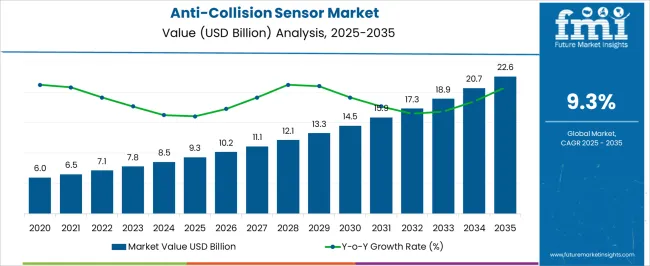
| Metric | Value |
|---|---|
| Anti-Collision Sensor Market Estimated Value in (2025 E) | USD 9.3 billion |
| Anti-Collision Sensor Market Forecast Value in (2035 F) | USD 22.6 billion |
| Forecast CAGR (2025 to 2035) | 9.3% |
The anti-collision sensor market is undergoing rapid growth, fueled by increasing demand for advanced driver assistance systems (ADAS), heightened vehicle safety mandates, and the global push toward autonomous mobility. Government regulations mandating crash avoidance technologies and rising consumer awareness about road safety have intensified OEM integration of sensor-driven safety systems.
Developments in real-time signal processing, AI-based perception algorithms, and sensor miniaturization are enhancing system accuracy and responsiveness, making these technologies more accessible across mid-range vehicles. Additionally, the proliferation of electric vehicles and the expansion of smart mobility infrastructure are creating new avenues for sensor deployment.
Looking ahead, sustained R&D investment, international safety standards compliance, and collaborations between automakers and technology providers are expected to shape the market’s next phase of innovation and penetration.
The anti-collision sensor market is segmented by sensor type, vehicle type, technology, end use, and geographic region. By sensor type, the market is divided into radar, ultrasonic, LiDAR, and camera sensors. In terms of vehicle type, it is classified into passenger vehicles and commercial vehicles. Based on technology, the market is segmented into adaptive cruise control (ACC), blind spot detection (BSD), forward collision warning (FCW), lane departure warning system (LDWS), and parking assistance. By end use, the market is categorized into automotive, aerospace and defense, railways, industrial, and construction. Regionally, the anti-collision sensor industry is classified into North America, Latin America, Western Europe, Eastern Europe, Balkan & Baltic Countries, Russia & Belarus, Central Asia, East Asia, South Asia & Pacific, and the Middle East & Africa.
The anti-collision sensor market is expanding due to the increasing demand for safety systems in automotive and industrial applications. Anti-collision sensors play a crucial role in preventing accidents by detecting obstacles and providing real-time alerts to operators. With rising concerns over road safety, government regulations, and advancements in sensor technologies, the market is witnessing substantial growth. The increasing adoption of advanced driver assistance systems (ADAS) and autonomous vehicles is further driving demand. While challenges related to high costs and technology integration exist, the market offers opportunities in emerging markets and technological innovations in sensor capabilities.
The growing demand for safety systems, particularly in the automotive sector, is driving the anti-collision sensor market. With the increasing frequency of road accidents and the growing emphasis on vehicle safety, anti-collision sensors have become a key feature in both passenger and commercial vehicles. The adoption of advanced driver assistance systems (ADAS), which integrate anti-collision sensors to provide features such as automatic emergency braking and lane-keeping assistance, is fueling market growth. Furthermore, the rise of autonomous vehicles that require precise obstacle detection and avoidance systems is driving the demand for more advanced anti-collision sensors, further expanding market opportunities.
A major challenge in the anti-collision sensor market is the high cost of advanced sensor technologies, which can limit adoption, especially in budget-sensitive sectors and regions. High-performance sensors, such as LiDAR and radar-based systems, can be expensive to manufacture and integrate into vehicles or industrial equipment. Moreover, integrating these sensors with existing vehicle or machinery control systems can be complex and require significant investment in software development, calibration, and testing. The complexity of ensuring accurate sensor functionality in various environmental conditions, such as adverse weather or low visibility, also presents a challenge. Overcoming these challenges requires continuous innovation in sensor technology to reduce costs while maintaining high performance and reliability.
The anti-collision sensor market offers substantial opportunities in emerging markets, where rising disposable incomes and increasing vehicle production are driving demand for advanced safety features. As automotive manufacturing expands in regions such as Asia-Pacific and Latin America, the demand for anti-collision sensors is growing. The advancements in sensor technology, such as the development of more compact and affordable LiDAR, radar, and ultrasonic sensors, are opening new growth avenues. The integration of AI and machine learning to enhance sensor accuracy and real-time decision-making also presents opportunities for innovation. The ongoing development of autonomous vehicles, which rely heavily on anti-collision sensors, further provides long-term growth potential in the market.
A key trend in the anti-collision sensor market is the increasing integration of artificial intelligence (AI) and multi-sensor fusion systems. AI is being used to enhance the performance of anti-collision sensors by improving obstacle detection, recognition, and response time. Multi-sensor fusion, where data from various sensors like radar, LiDAR, and cameras are combined to provide a more accurate and reliable understanding of the environment, is gaining traction. This technology allows for better decision-making and improves the overall performance of anti-collision systems. As the automotive industry shifts toward full automation, these trends are becoming more prevalent, with manufacturers focusing on developing sensors that can handle complex and dynamic driving environments while ensuring safety and efficiency.
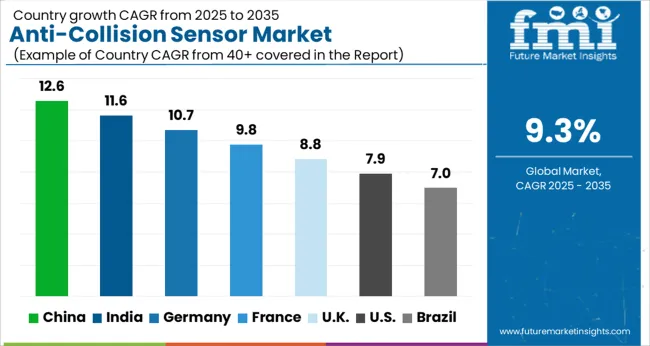
The anti-collision sensor market is expected to grow at a global CAGR of 9.3% from 2025 to 2035. China leads with a CAGR of 12.6%, followed by India at 11.6%, and France at 9.8%. The United Kingdom records 8.8%, while the United States stands at 7.9%. China and India show robust growth driven by their expanding automotive industries, government initiatives, and increasing demand for safety features in vehicles. Meanwhile, OECD nations like France, the UK, and the USA exhibit steady growth due to stricter regulations around vehicle safety and rising demand for advanced driver assistance systems (ADAS) in the automotive sector. The analysis spans over 40+ countries, with the leading markets shown below.
China is projected to grow at a CAGR of 12.6% through 2035, driven by the country’s rapidly expanding automotive sector and its increasing focus on vehicle safety. The adoption of anti-collision sensors is being propelled by rising consumer demand for safety features, especially in electric vehicles (EVs) and high-end models. The government’s support for advanced safety technologies, coupled with rising urbanization and road traffic, is further boosting the demand for collision avoidance systems. China’s strong emphasis on electric vehicle production and sales also contributes to market growth, as EVs often incorporate advanced safety features like anti-collision sensors.
India is projected to grow at a CAGR of 11.6% through 2035, driven by the rapid expansion of the automotive industry and increasing consumer demand for safety features in vehicles. The Indian government’s push for stricter vehicle safety regulations and the growing awareness about road safety are key drivers for the adoption of anti-collision sensors in the country. The rise in disposable incomes and the increasing demand for advanced driver assistance systems (ADAS) also contribute to the market’s growth. Moreover, the growing presence of global automotive manufacturers in India is driving innovation and adoption of new safety technologies.
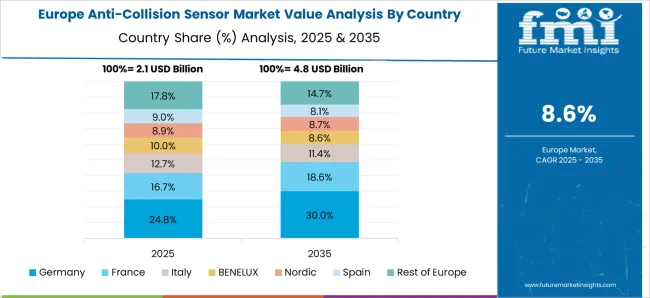
France is projected to grow at a CAGR of 9.8% through 2035, supported by the increasing demand for vehicle safety systems, particularly in the automotive sector. The French automotive industry is embracing ADAS technologies, including anti-collision sensors, to meet stricter safety regulations and improve the overall driving experience. As the demand for electric vehicles and hybrid cars rises, the need for advanced safety features, such as collision avoidance systems, also grows. The French government’s efforts to promote road safety and enhance infrastructure further contribute to the market’s expansion.
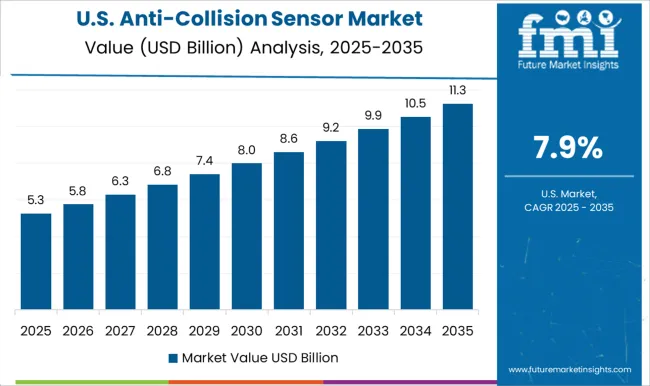
The United States is projected to grow at a CAGR of 7.9% through 2035, with the increasing adoption of advanced driver assistance systems (ADAS) being a major driver for the anti-collision sensor market. The USA automotive industry is focusing on improving vehicle safety, and government regulations are pushing for the integration of more safety features in vehicles. With the rise of electric vehicles and autonomous driving technology, the demand for anti-collision sensors in the USA is expected to increase significantly. The focus on reducing traffic accidents and enhancing the driving experience contributes to the expansion of the market.
The United Kingdom is projected to grow at a CAGR of 8.8% through 2035, driven by the growing demand for vehicle safety features in the automotive sector. The UK automotive industry is increasingly adopting ADAS technologies, including anti-collision sensors, to improve road safety and meet regulatory requirements. The rise in electric vehicles and government incentives for safer, eco-friendly vehicles contribute to the growing adoption of advanced safety features. The UK’s stringent vehicle safety regulations and increasing consumer preference for safer, more technologically advanced vehicles further support the demand for anti-collision sensors.
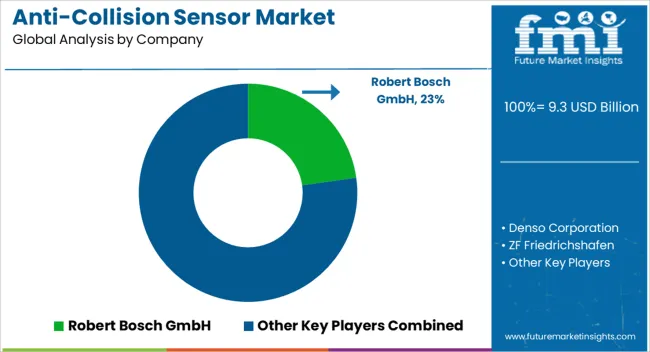
The anti-collision sensor market is driven by leading global players specializing in sensor technologies for automotive safety systems. Robert Bosch GmbH is a market leader, providing advanced sensor solutions that improve vehicle safety by preventing collisions and enabling autonomous driving features. Denso Corporation and ZF Friedrichshafen offer cutting-edge anti-collision sensors, focusing on radar, lidar, and camera technologies to enhance driver assistance systems in both conventional and electric vehicles. Delphi Automotive (now part of Aptiv) and Yaskawa provide robust sensor solutions, with a focus on improving accuracy, reaction time, and real-time data processing for collision avoidance in high-speed environments.
Continental AG offers a wide range of sensors for automotive safety, including radar, ultrasonic, and infrared sensors, which are integral to advanced driver assistance systems (ADAS). Wadeco specializes in radar-based anti-collision sensors, targeting niche markets such as autonomous vehicles and robotic applications. These companies differentiate themselves by integrating sensor technology with other vehicle systems, improving vehicle autonomy, and providing multi-sensor fusion capabilities for enhanced collision detection and safety. Competitive differentiation in this market is driven by sensor accuracy, integration with vehicle systems, cost-efficiency, and the ability to meet regulatory standards. Barriers to entry include high research and development costs, regulatory compliance, and the need for reliable partnerships with automotive manufacturers. Strategic priorities include enhancing sensor range, improving object detection in various environmental conditions, and advancing sensor fusion technology to support autonomous vehicle development.
| Item | Value |
|---|---|
| Quantitative Units | USD Billion |
| Sensor Type | Radar, Ultrasonic, LiDAR, and Camera |
| Vehicle Type | Passenger Vehicles and Commercial Vehicles |
| Technology | Adaptive Cruise Control (ACC), Blind Spot Detection (BSD), Forward Collision Warning (FCW), Lane Departure Warning System (LDWS), and Parking Assistance |
| End Use | Automotive, Aerospace and Defense, Railways, Industrial, and Construction |
| Regions Covered | North America, Europe, Asia-Pacific, Latin America, Middle East & Africa |
| Country Covered | United States, Canada, Germany, France, United Kingdom, China, Japan, India, Brazil, South Africa |
| Key Companies Profiled | Robert Bosch GmbH, Denso Corporation, ZF Friedrichshafen, Delphi Automotive, Yaskawa, Continental AG, and Wadeco |
| Additional Attributes | Dollar sales by sensor type (radar sensors, lidar sensors, ultrasonic sensors, camera sensors) and end-use segments (passenger vehicles, commercial vehicles, autonomous vehicles). Demand dynamics are driven by the increasing adoption of ADAS, growing automotive safety regulations, and the rising focus on preventing accidents in the automotive sector. Regional trends indicate strong growth in North America and Europe due to regulatory mandates and the shift towards autonomous vehicles, while Asia-Pacific is expanding rapidly with increasing automotive production and technological advancements. |
The global anti-collision sensor market is estimated to be valued at USD 9.3 billion in 2025.
The market size for the anti-collision sensor market is projected to reach USD 22.6 billion by 2035.
The anti-collision sensor market is expected to grow at a 9.3% CAGR between 2025 and 2035.
The key product types in anti-collision sensor market are radar, ultrasonic, lidar and camera.
In terms of vehicle type, passenger vehicles segment to command 56.2% share in the anti-collision sensor market in 2025.






Full Research Suite comprises of:
Market outlook & trends analysis
Interviews & case studies
Strategic recommendations
Vendor profiles & capabilities analysis
5-year forecasts
8 regions and 60+ country-level data splits
Market segment data splits
12 months of continuous data updates
DELIVERED AS:
PDF EXCEL ONLINE
Sensor Fusion Market Size and Share Forecast Outlook 2025 to 2035
Sensor Based Glucose Measuring Systems Market Size and Share Forecast Outlook 2025 to 2035
Sensor Development Kit Market Size and Share Forecast Outlook 2025 to 2035
Sensory Modifier Market Size and Share Forecast Outlook 2025 to 2035
Sensor Bearings Market Insights - Growth & Forecast 2025 to 2035
Sensor Hub Market Analysis - Growth, Demand & Forecast 2025 to 2035
Sensor Patches Market Analysis - Growth, Applications & Outlook 2025 to 2035
Sensors Market Analysis by Type, Technology, End User & Region - Forecast from 2025 to 2035
Sensor Data Analytics Market Growth - Trends & Forecast through 2034
Sensor Testing Market Analysis – Growth & Forecast 2024-2034
Sensor Cable Market
Sensormatic Labels Market
3D Sensor Market Size and Share Forecast Outlook 2025 to 2035
Biosensors Market Trends – Growth & Future Outlook 2025 to 2035
UV Sensors Market Analysis by Type, End User, and Region from 2025 to 2035
CP Sensor for Consumer Applications Market – Growth & Forecast 2025 to 2035
Nanosensors Market Size and Share Forecast Outlook 2025 to 2035
NOx Sensor Market Size and Share Forecast Outlook 2025 to 2035
VOC Sensors and Monitors Market Analysis - Size, Growth, and Forecast 2025 to 2035
Rain Sensors Market Size and Share Forecast Outlook 2025 to 2035

Thank you!
You will receive an email from our Business Development Manager. Please be sure to check your SPAM/JUNK folder too.
Chat With
MaRIA